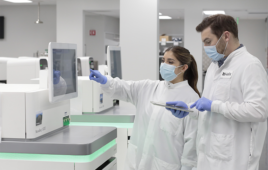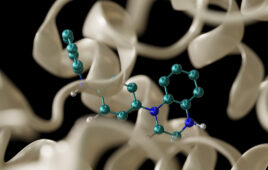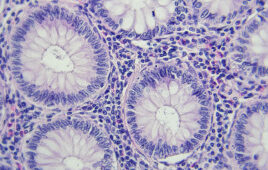Preventing RNA degradation is difficult, but newer systems for protecting this molecule may lead the way to better gene expression analysis.
RNA integrity is crucial for obtaining reliable and meaningful gene expression data. Using highly-purified, intact RNA samples is a key component for the successful application of modern molecular biology and diagnostic techniques such as quantitative real-time PCR (qRT-PCR) or microarray analysis. qRT-PCR realizes the inherent quantitative potential of PCR, making it a quantitative, as well as qualitative, assay that is the method of choice for the detection of mRNA. While qRT-PCR has been transformed into a mainstream research tool, there are limitations to the technology. A lack of standardization and normalization can make it difficult to draw definitive conclusions about the biological validity of quantitative data. The intimate association between quantification and amplification efficiency during the reverse transcription step highlights the critical importance of using mRNA that is of high quality and integrity as the starting point for the reaction.
While the dynamic state of cells makes it inevitable that there will be inherent variation in RNA prepared from biological samples, it is the hands-on purification, handling and storage of these samples that often leads to artificial and inadvertent variation, particularly given the highly labile nature of the molecule and tendency to degrade even under carefully controlled RNase-free conditions and cold storage. Even a short period of slightly-elevated temperatures can compromise RNA integrity and detrimentally affect performance in downstream assays. The seemingly straightforward step of converting RNA into cDNA templates is an important contributor to the variability and lack of reproducibility frequently observed in qRT-PCR analysis, particularly if the integrity of the RNA is compromised. RNA used as template should be highly purified to prevent enzyme inhibition or interference from residual contaminants. The RNA should also be full-length and intact, particularly if using oligo-d(T) for priming the reverse transcription reaction. Oligo-d(T) is used to prime almost half of RT-qPCR assays, compared to random and targeted priming.1 This method is most effective when the aim is to obtain faithful cDNA representation of the entire mRNA population or to amplify several target mRNAs from a limited RNA sample. However, as oligo-d(T) priming requires full-length RNA, it is not an effective choice for transcribing RNA that is likely to be degraded or fragmented, such as is typically obtained from archival material.
To ensure optimal and reliable results, proper RNA sample preparation, purification, and storage techniques must be adhered to and practiced routinely in the laboratory. Appropriate storage of samples both before and after processing is of particular importance to preserve the integrity of RNA in tissues and cells. Commercially-available products such as RNAlater (Ambion, Austin, Texas) have enabled successful preservation of tissues and cells for long-term storage at cold or freezing temperatures prior to purification. Room temperature storage (18°C to ?25°C) in RNAlater is even possible for up to seven days according to manufacturer’s instructions, although significant mRNA degradation was detected after rat liver samples soaked in RNAlater were stored for three days at room temperature.2 The use of ambient environment tissue preservatives has made it practical to engage clinicians and researchers directly in decentralized sample collection for subsequent analysis in a central location. Upon receipt in a centralized facility, the samples are either processed immediately or archived at freezing temperatures.3
Currently, RNA can be purified using strong denaturants such as LiCl, SDS, phenol, and guanidine isothiocyante (e.g., TRIzol Reagent from Invitrogen and TRI Reagent from Ambion), or with commercially-available kits incorporating filter-based RNA isolation, or magnetic bead-based technology. Purified RNA samples are handled minimally and kept cold at all times until ready for use. Samples are typically stored frozen (-20°C to -80°C; or in liquid nitrogen) in RNase?free solutions or alcohol and thawed on ice only when needed. Multiple freeze-thaw cycles and prolonged exposure to increased temperatures are avoided as these conditions serve to promote RNA degradation. It has been reported that moderately degraded RNA samples can be used to generate a reasonable qRT-PCR expression profile4; however, this same study highlights that qRT-PCR performance is affected by RNA integrity and stresses the importance of assessing RNA quality and including an invariant endogenous control to correct for sample variations in order to generate useful and meaningful qRT-PCR data.
Despite the precautions taken to maintain purified RNA samples in constant cold environments, the integrity of a sample is often compromised using current cold storage methodologies, particularly during long-term storage or sample transport, where shipment delays are a common and frequent occurrence. GenVault and RNAworks are two companies that offer room temperature RNA storage products that are based on a reversible porous matrix (RPM) and chemical modification of the RNA molecule, respectively. In the case of RPM, where RNA samples are stored dry in nanoparticle beads, the beads must be purified away from the sample prior to further downstream analysis. RNA stabilized by chemical modification results in the complete covalent modification of 2’-OH groups on the molecule that can be reversed, but requires additional reagents and reaction time. In addition, RNA molecules lacking inherent 2’-OH groups no longer retain any secondary or tertiary structures, interactions that can be critical for some RNA molecules, such as catalytic RNAs.
Biomatrica has developed an alternative technology for storing purified total RNA samples dry at room temperature. RNAstable was designed based on the principles of anhydrobiosis (meaning “life without water”), a biological mechanism employed by some multicellular organisms that enables their survival while dry for up to 120 years.5 RNAstable is a synthetic matrix that works by forming a thermo-stable barrier around RNA during the drying process to protect samples from degradation during dry storage at ambient or even elevated temperatures (Figure 1). RNA has been successfully stored in RNAstable for up to six months at room temperature. Complete sample recovery is achieved by rehydration with water and can be used directly in downstream applications such as qRT-PCR without further purification, thus eliminating sample loss typically associated with traditional salt precipitations and accompanying wash steps. RNAstable can also be used to concentrate RNA samples with significantly improved yields as compared to traditional methods. Up to 100µg of total purified RNA in a maximum volume of 100µl can be applied directly into tubes or wells containing RNAstable and dried for storage at ambient temperatures and even up to 50°C. This application is particularly advantageous for concentrating dilute samples containing limited amounts of RNA. The presence of the matrix in the rehydrated sample does not inhibit or interfere with downstream reactions or assays such as qRT-PCR, microarray and bioanalyzer analysis, agarose gel electrophoresis or cDNA synthesis; therefore, recovered samples can be used directly without the need for further purification.6
To assess the compatibility of RNA stored in RNAstable for use in qRT-PCR analysis, aliquots (0.5µg) of 293T-cell-purified total RNA were applied to RNAstable and stored dry at 50°C with a relative humidity of <50% for four months. Samples were subsequently rehydrated with DEPC-treated water and an aliquot was run on a 1.2% Tris-acetat-EDTA gel stained with ethidium bromide (Figure 2A). Results indicate that the integrity of RNA protected in RNAstable is comparable to samples stored at -80°C (i.e., no degradation). In contrast, unprotected RNA stored at 50°C for the same time period was completely degraded. An aliquot (100ng) of the freezer-stored RNA sample and the sample protected in RNAstable was quantified using TaqMan One-step RT-PCR reagents (ABI). Rehydrated samples recovered from storage in RNAstable were used directly in reactions without further purification to remove the matrix. Triplicate reactions were performed for each storage condition and the results from the six reactions are overlaid on the graph shown in Figure 2B. Recovered amounts of total RNA stored in RNAstable (84.27ng ±2.34) for three months at 50°C are comparable to control RNA samples stored frozen at -80°C (85.26ng ±5.85) (Figure 2C), indicating protection of RNA in the matrix is as effective as freezer storage, even at extremely elevated temperatures. These results further demonstrate compatibility of RNAstable for qRT-PCR analysis, as the presence of the matrix did not exhibit any interference or inhibition in the reactions or during thermocycling.
Quantitative RT-PCR is extremely powerful and can generate reliable, reproducible, and biologically relevant results provided that scientists are aware of the limitations and pitfalls of the technology. The starting point for successful transcriptome analysis is high-quality mRNA. Technology advances in sample preservation that can prevent the degradation process of biological samples will enable the acquisition of more accurate and reliable results.
About the Author
Peggy Ho Faix, PhD, project manager at Biomatrica (San Diego), has advanced programs focused on molecular virology and combinatorial library screening for biomedical research at the NIH and companies such as Selective Genetics, Inc.
This article was published in Drug Discovery & Development magazine: Vol. 11, No. 4, April, 2008, pp. 44-47.
|
Filed Under: Genomics/Proteomics



